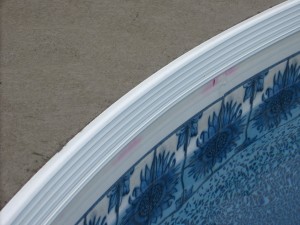Micro-organism activity
Another type of grey/black-coloured stain can occur as a result of micro-organism activity on the back side of the liner. These micro-organisms can produce dyes that are soluble in the plasticizers used to make the vinyl liner pliable. The microbial dye becomes visible on the pool side of the liner as it migrates through the liner material, creating an unsightly, irregular-shaped blotch.
These stains can be diminished on the pool side via super chlorination; however, they will eventually reappear since the source of the stain originates from behind the liner. Installation of a polyethylene barrier, between the vinyl liner and the pool’s walls and floor, may prevent these stains from occurring.
Finally, when closing a pool for the season, a winter or safety cover that seals tightly around the pool perimeter can be used to prevent organic debris (e.g. leaves and insects) from accumulating over the winter months. If the pool is not covered properly, this type of debris will accumulate and possibly cause staining, and discolouration on vinyl liner surfaces. Under certain conditions, one such unsightly result can be the formation of pink stains on the liner.
Pink staining

Pink blotches, which can appear on vinyl liners of all colours, are typically caused by an indelible pink dye excreted by bacterial micro-organisms. This dye can easily migrate through the entire thickness of the liner as it is highly soluble in the plasticizers used in flexible polyvinyl chloride (PVC) pool liners.
Bacterial micro-organisms can grow on either side of the pool liner. For instance, growth on the water side of the liner may occur if free chlorine levels are allowed to fall below 1.5 ppm at the same time organic matter and bacteria have been allowed to accumulate in the water. At this stage, super chlorinating will rid the pool water of the contamination and bleach the portion of the dye that is exposed on the liner’s surface. However, if the dye has already penetrated the liner’s surface, staining will tend to linger indefinitely.
Further, growth on the backside of the liner may not take place directly on the vinyl but rather on other materials the liner is in contact with such as soil and various insulating materials (e.g. felt and tape). Even though anti-microbial agents are incorporated into the vinyl formulation, the dye can migrate from unprotected components and stain areas well beyond the point of infestation. If there is a lot of pink dye visible on the rear side of the liner or any backing material, it can certainly be considered the source of the problem.
If the liner is replaced, all contaminated materials must be removed and the entire pool shell (floor and walls) must be disinfected with a liquid chlorine spray or another suitable disinfectant.
Additional problems may also occur in low-lying areas or those with high water tables, which are more likely to contain higher concentrations of bacterial micro-organisms that are continually brought to the backside of the liner. Using disinfectants at these sites may prove to be ineffective as they will be quickly washed away. Installing a barrier layer—either a polyethylene sheet between the pool shell and liner or a coating applied directly to the pool shell—may work as a possible line of defense in these situations.
Stains from bleaching
The addition of water treatment chemicals can also damage a vinyl liner if they are not sufficiently circulated in the water. For example, chemicals such as chlorine can settle in the pool’s deep end and bleach the liner if the water is not circulated for several hours before the pool is closed for the season.
Spot bleaching can also occur if calcium hypochlorite (Ca[ClO]2) particles or other slow-dissolving sanitizers are allowed to settle on the pool floor. This can be easily prevented by dissolving sanitizers in a bucket of pool water prior to adding them to the pool. After the sanitizer has dissolved, pour it into the pool using a sieve.
Using large, single doses of hydrochloric (muriatic) acid to adjust pH or total alkalinity levels can also cause damage. Again, if the chemical is not sufficiently blended with the pool water, the acid can chemically attack the liner’s printed pattern.
Printed vinyl liners with base colours such as white, turquoise, light blue, grey and dark royal blue typically have excellent resistance to chlorine bleaching. However, medium blue vinyl liners are more susceptible to bleaching or colour loss, in as little as six to 24 hours, if exposed to high concentrations of trichloroisocyanurate stabilized chlorine. This is due to the chemical’s high available chlorine content (90 per cent), its low solubility or rate of dissipation (granules/pucks), and the extremely low pH produced in the contact area.
The immediate effect of other types of chlorine such as sodium dichloroisocyanurate (NaDCC), calcium hypochlorite, sodium hypochlorite (NaClO) (liquid chlorine) is not as rapid or severe as long as they are not dissolved and/or mixed with other chemicals during or shortly after being added to the pool.
These chlorine variations can usually be applied directly to the vinyl liner material for short-term exposures to bleach out stains without adverse effects. However, if the concentrations are allowed to remain higher than the recommended level of 5 ppm for super chlorination, or 10 ppm for shocking, for long periods of time, gradual bleaching of most liners will occur. It is always recommended to try a very small test area when attempting to remove a stain from a liner, and evaluate the results before proceeding with the treatment.
Further, any chemical added to pool water should be allowed to circulate before adding another chemical as certain combinations, at high concentrations, can also cause liner bleaching.






